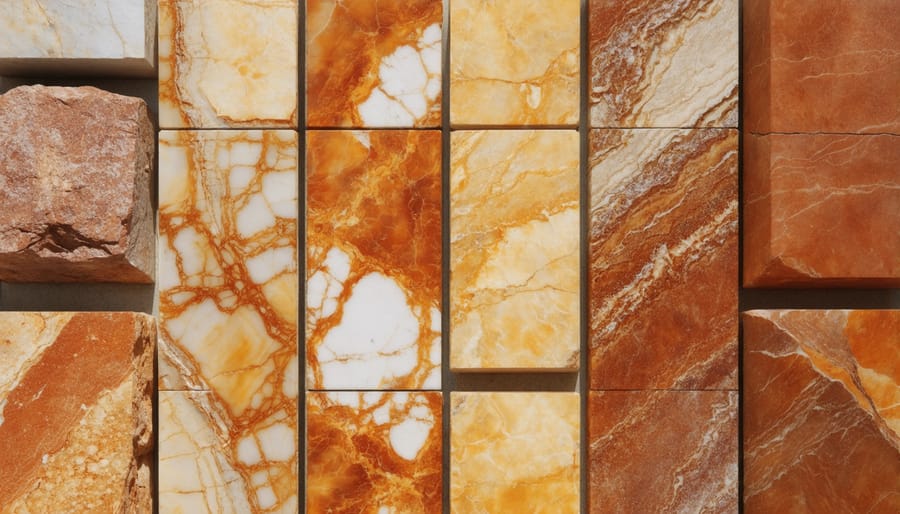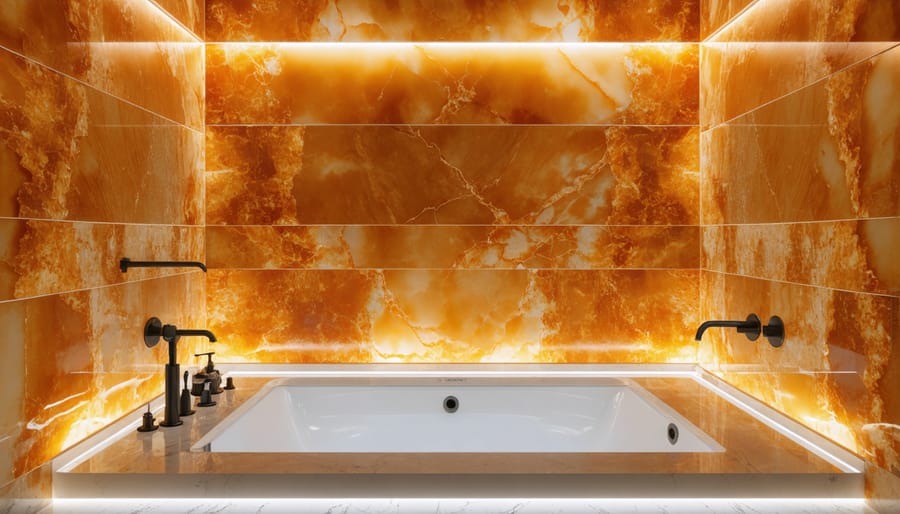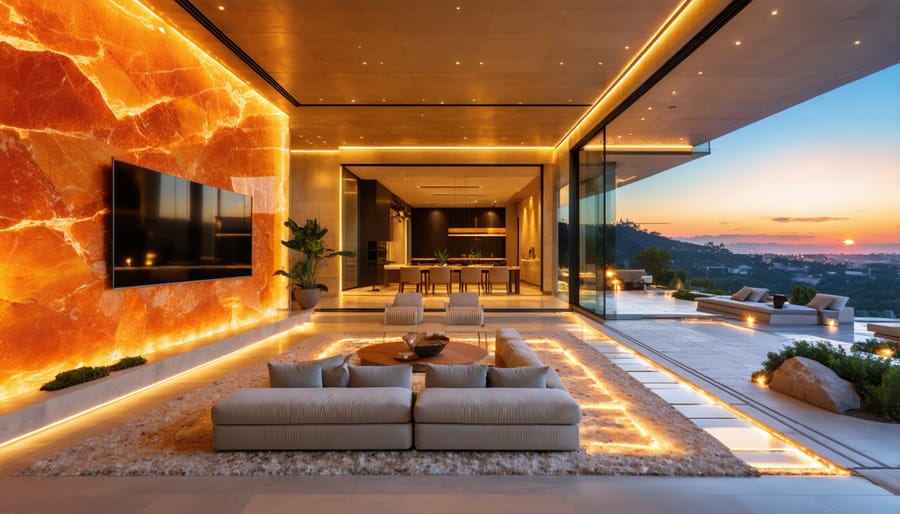Discover the timeless allure of orange natural stone, where earth’s vibrant palette meets architectural excellence. From the warm honey hues of Golden Sienna sandstone to the bold rust tones of Sunset quartzite, these remarkable materials have graced everything from ancient Roman temples to modern luxury homes. Nature’s masterful combination of iron-rich minerals and geological processes has created these striking orange stones, each telling a unique story through their varied patterns, textures, and color intensities. Today’s designers and homeowners increasingly seek these distinctive materials to create dramatic focal points and harmonious connections between indoor and outdoor spaces. Whether used in countertops, wall cladding, or landscape features, orange natural stone offers an extraordinary blend of durability and aesthetic appeal that transforms ordinary spaces into extraordinary environments.

Types of Orange Natural Stone
Honey Onyx
Honey Onyx, prized for its translucent golden-orange hues, offers a luxurious and warm aesthetic that captivates designers and homeowners alike. This semi-precious stone features distinctive bands and swirls that create mesmerizing patterns when backlit, making it particularly striking in hospitality and high-end residential applications. The stone’s crystalline structure allows light to penetrate several millimeters deep, creating a luminous effect that adds depth and sophistication to any space.
Commonly used in feature walls, backsplashes, and vanity tops, Honey Onyx delivers dramatic visual impact while maintaining a sense of natural elegance. Its versatility extends to both vertical and horizontal applications, though proper sealing is essential due to its relatively soft nature. When properly maintained, this stunning material can transform ordinary spaces into extraordinary environments, especially when incorporated into lighting designs that highlight its translucent properties.
Orange Travertine
Orange travertine offers a warm, inviting presence with its distinctive honey and amber tones. This sedimentary stone features unique patterns of bands and swirls, created by mineral deposits over millions of years. Persian Gold and Autumn Blend are popular varieties that showcase rich orange hues mixed with cream and brown undertones. The stone’s natural pitting and texture add character while providing excellent slip resistance, making it ideal for both indoor and outdoor applications.
Commonly used in flooring, wall cladding, and pool decks, orange travertine maintains its beauty even in high-traffic areas. Its versatility allows for various finishes, from polished to tumbled, each highlighting different aspects of the stone’s natural coloration. While more porous than some natural stones, proper sealing ensures durability and longevity. The material’s thermal properties also make it an excellent choice for outdoor spaces in warm climates, as it remains cool underfoot.
Sunset Sandstone
Sunset Sandstone showcases warm, orange-to-amber hues that evoke the colors of a desert evening. This versatile natural stone forms through the compression of mineral-rich sand deposits, often containing high levels of iron oxide, which creates its distinctive orange coloration. Popular varieties include Arizona Sunrise, Indian Autumn, and Copper Canyon sandstone, each offering unique patterns of striations and color variations. The stone’s natural warmth makes it an excellent choice for both interior and exterior applications, from accent walls to outdoor pavers. Its medium hardness and textured surface provide good slip resistance, while its earthy tones complement both modern and rustic design schemes. The color intensity can vary from subtle salmon pink to deep burnt orange, allowing designers to select the perfect shade for their specific project needs.
Natural Color Variations in Orange Stone
Geological Factors
The distinctive orange hue found in natural stone primarily results from the presence of iron oxide minerals, particularly hematite and limonite. During the stone’s formation process, these minerals interact with other compounds under specific temperature and pressure conditions, creating the warm orange tones that make these stones so desirable in design applications.
The intensity and variation of orange coloration depend on several geological factors. Sedimentary rocks, such as sandstone, often develop their orange color through the oxidation of iron-bearing minerals over millions of years. In metamorphic stones, the orange hue can emerge through the recrystallization of minerals under intense heat and pressure, while igneous rocks may acquire their orange tones during the cooling of mineral-rich magma.
Environmental conditions during formation also play a crucial role. Stones formed in oxygen-rich environments tend to develop more pronounced orange colors due to increased iron oxidation. The presence of trace elements like manganese can influence the final color, creating subtle variations from pale peach to deep rust tones.
The distribution of minerals throughout the stone determines whether the orange coloration appears uniform or creates striking patterns. Some stones exhibit dramatic veining or mottled effects due to mineral concentrations varying during the formation process, while others maintain a more consistent color throughout their structure.
Pattern Variations
Orange natural stone exhibits a fascinating array of patterns and veining that make each piece uniquely beautiful. The most common pattern variations include linear striations, which appear as parallel lines running through the stone, and swirling patterns that create dynamic movement across the surface. These patterns are formed by mineral deposits and geological processes over millions of years.
In quartzite and sandstone varieties, you’ll often find subtle waves and ripples reminiscent of desert landscapes. Orange marble typically displays bold, dramatic veining in contrasting colors like white, grey, or deep rust, creating striking visual interest. Some specimens feature speckled or mottled patterns, where darker mineral deposits create a textured appearance against the orange background.
Onyx varieties showcase translucent bands that appear to flow like honey, often with varying degrees of transparency. Turkish and Persian travertine demonstrate distinctive linear patterns formed by mineral precipitation, sometimes incorporating fossilized organic matter that adds character to the stone.
The intensity and distribution of these patterns can vary significantly even within the same stone type. Some pieces may exhibit gentle, understated patterns ideal for contemporary designs, while others showcase bold, dramatic veining perfect for making a statement in traditional or modern spaces. Understanding these pattern variations is crucial for selecting the right stone for specific design applications and achieving the desired aesthetic impact.

Design Applications
Interior Applications
Orange natural stone brings warmth and sophistication to interior spaces, making it a versatile choice for various natural stone flooring applications and design elements. In kitchens, orange-toned granite or quartzite countertops create striking focal points while offering exceptional durability for daily use. The rich, earthy hues complement both contemporary and traditional cabinetry styles.
For flooring, orange travertine and sandstone tiles provide elegant solutions that add character to entryways, living rooms, and bathrooms. These materials offer natural slip resistance and maintain comfortable temperatures year-round. When used as accent walls or fireplace surrounds, orange natural stone creates dramatic visual impact while introducing organic textures to interior spaces.
In bathroom designs, orange onyx brings luxury through its translucent properties, especially when backlit. Its unique patterns and warm glow create spa-like atmospheres perfect for relaxation. For smaller applications, orange marble mosaic tiles make stunning backsplashes or shower features.
Consider lighting conditions when selecting orange stone for interiors, as natural and artificial light can significantly affect color perception. South-facing rooms may intensify orange tones, while north-facing spaces might benefit from the stone’s warming effects. Pair orange stone with neutral colors for balance, or create bold statements by combining it with complementary blue or green elements.

Exterior Applications
Orange natural stone proves to be an exceptional choice for exterior applications, offering both aesthetic appeal and durability in outdoor environments. Its warm, vibrant tones can create striking facades, elegant pathways, and inviting outdoor living spaces while withstanding various weather conditions.
Common exterior applications include driveway pavers, garden pathways, pool decking, and exterior wall cladding. The stone’s natural variations in color and texture add depth and character to outdoor designs, particularly in Mediterranean, desert, or contemporary architectural styles. When used for retaining walls or landscape features, orange stone creates a seamless transition between built structures and natural surroundings.
However, proper consideration must be given to weathering factors. While most orange stones are naturally resistant to weathering, regular sealing is recommended to protect against UV exposure, which can gradually fade the rich orange hues. In regions with freeze-thaw cycles, selecting stones with appropriate density and porosity ratings is crucial to prevent cracking or spalling.
For optimal performance in exterior settings, choose varieties like orange quartzite or granite, which offer superior durability and color stability. Sandstone varieties should be carefully selected based on their density and regional climate conditions. Professional installation with proper drainage systems and joint spacing helps ensure longevity and maintains the stone’s aesthetic appeal throughout seasonal changes.
Maintenance and Care
Regular maintenance is essential for preserving the beauty and longevity of orange natural stone surfaces. The key to maintaining natural stone is consistent care with appropriate cleaning products. Use pH-neutral cleaners specifically designed for natural stone, and avoid acidic or abrasive cleaning solutions that can damage the surface.
For daily cleaning, simply dust mop interior floors and wipe countertops with a soft, damp cloth. Clean spills immediately to prevent staining, particularly from acidic substances like wine, citrus juices, or tomato sauce. Regularly seal your orange stone surfaces according to manufacturer recommendations, typically every 12-18 months, to protect against staining and wear.
For outdoor applications, periodically inspect for signs of weathering or damage. Remove organic debris promptly and clean with appropriate stone cleaners. During winter, avoid using de-icing salts near orange stone installations, as these can cause erosion and color fading. Professional deep cleaning and restoration services are recommended every few years to maintain the stone’s original luster and protect your investment.
Orange natural stone stands as a remarkable choice for both interior and exterior applications, offering a unique blend of warmth, durability, and natural beauty. From the striking patterns of Baltic Sunset granite to the subtle hues of Honey onyx, these stones provide designers and homeowners with versatile options for creating distinctive spaces. Their timeless appeal, combined with proper maintenance and care, ensures lasting beauty and value. Whether used in countertops, flooring, or decorative elements, orange natural stones bring the perfect balance of elegance and energy to any design project. Their ability to complement various color schemes and architectural styles makes them an enduring choice for those seeking to make a bold yet sophisticated statement in their spaces.










